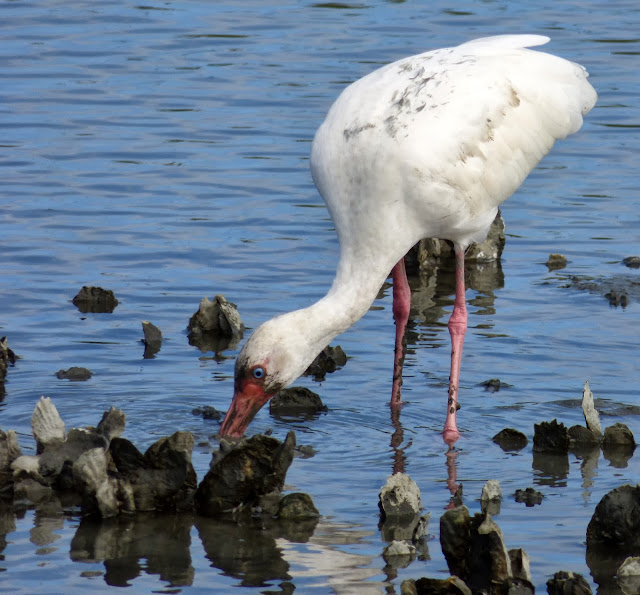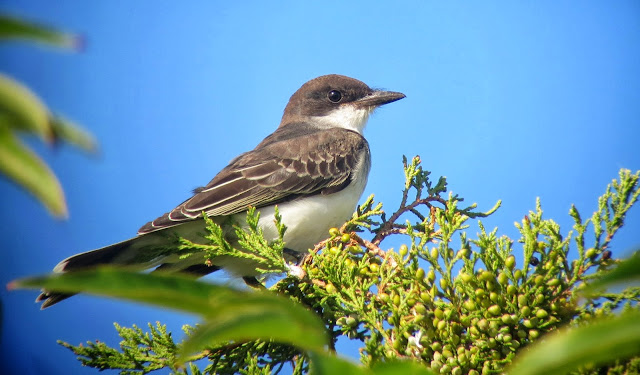I was warned that it could become "the Bataan Bug March," but thanks to cool temperatures and a steady breeze the deer flies and mosquitos were only a minor annoyance on the trip I led Santee Coastal Reserve last weekend.
 |
| A pleasant day for birding at Santee Coastal Preserve, 9/27/2013, photo by Natalia Ocampo-Penuela |
It is not often that I venture south of the border to go birding and when I do, it's usually a Carolina Bird Club meeting that entices me to do so. The difference with this CBC meeting at Litchfield Beach, was all the extra hats I was juggling. I was brought in not only to lead field trips, but also had the honor of delivering the Saturday night talk, a lecture on my dissertation research.
 |
| Title slide from my talk at the Carolina Bird Club fall meeting |
And I had an executive committee meeting to attend since I was recently appointed to serve as a Vice President of the CBC representing Eastern North Carolina.
But y'all came here for birds...where were we...
 |
| Red-Cockaded Woodpecker Santee Coastal Reserve |
 |
| Red-Cockaded Woodpecker Santee Coastal Reserve |
That's right, birding Santee Coastal Reserve, a huge piece of public land that borders the Santee River and contains a diverse array of bird-filled habitats including a nice patch of well-managed longleaf pine savannah that seemed to be loaded with Red-cockaded Woodpeckers.
 |
| Tricolored Heron, Santee Coastal Reserve |
It also has several large impoundments that provide habitat for wading birds and waterfowl. While the ducks don't arrive
en masse until later in the fall, we stumbled upon a small flock of early Northern Pintail, which was a nice surprise.
But the highlight for most of us on this trip was a rail. We were hearing Sora calling from all over the place down in the impoundments and with some patience we were all able to see one picking its way along the edge of a canal.
 |
| Sora, Santee Coastal Reserve |
This was actually the first Sora I had ever gotten a good look at and clears out the North American rails for my life list (at least until the Clapper/King complex gets split up).
The deciduous woods were hit-and-miss with warbler flocks and we ended up with about 70 species for the day, pushing my South Carolina state list well over the century mark.
I was supposed to lead the same trip the following day, but only one person signed up and it got cancelled. This was fortuitous for me because I desperately needed to get my talk finished (so I could deliver it that night!) It also allowed Natalia and I to slip off and bird one the best spots in the state conveniently located a couple miles from the hotel, Huntington Beach State Park.
 |
| White Ibis, Huntington Beach State Park |
The causeway leading into the park provides phenomenal views into a vibrant salt marsh. For a nice change, the crowds of visitors actually enhance the birding experience; because so many people are bustling by, the normally wary wading birds have little fear of people here.
 |
| Wood Stork, Huntington Beach State Park |
There were approx. 80 wood storks working the marsh and some seemed pretty oblivious to onlooking hominids.
But one of the big draws to this park in the warmer months are the Roseate Spoonbills. We were lamenting the fact that we couldn't find them, when a pair flew right over our heads and settled by the boardwalk in front of us.
 |
| Roseate Spoonbills, Huntington Beach State Park |
They make it up to NC every now and again, but this is about the northernmost spot they can found reliably found.
 |
| Roseate Spoonbills, Huntington Beach State Park |
I've been pondering the biogeochemical implications of that spatulate bill...
Contuing our good luck with rails, we managed to spot a Clapper Rail working the marsh, a life bird for Natalia!
 |
| Clapper Rail, Huntington Beach State Park |
Just before leaving we finally got to see the male Painted Bunting at the feeders by the nature center.
 |
| Painted Buntings, Huntington Beach State Park |
While the birding in the Palmetto State isn't a world apart from what can be had at the NC coast, it's always nice to bird some new hotspots and meet some new birders. And the talk went over very well. Who knew that bird biogeochemistry could be so comical? Apparently birders are suckers for poop jokes.
The next CBC meeting is at the end of January in Wrightsville Beach. Hope to see you there!


















